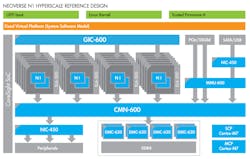Arm has been trying to get into the enterprise space that Intel has dominated for some time. It’s had more success in the embedded and commercial space, where low-power processors can be an advantage and where the ability to develop custom chips can also deliver superior solutions. A number of multicore, 64-bit Arm-based chips have emerged, but most of those have found success in specific areas like storage or networking.
Certain chips have targeted the enterprise. However, they never made a significant dent in the x86 enterprise arena. This next round of chips may change the narrative.
The start of this trend is based on Arm’s Neoverse N1 platform. The 64-bit core is specifically designed for the enterprise and the cloud. It includes the type of optimizations that have been common in the x86 server architecture, which are different than the consumer and industrial Arm cores.
Amazon Web Services (AWS) is investing in Arm-based servers, which could make the difference this time around. The company is also investing in Neoverse N1 by using its own chips. The first of these, called the Graviton2, allows AWS to utilize a chip designed to their specifications rather than going with an off-the-shelf offering. AWS has the scale where a custom chip can offer substantial cost and power advantages. It could also be more economical than buying from an outside party.
Amazon also has a massive customer base; it’s just a matter of convincing a large enough contingent to use its Arm-based solution to make it economically viable. Most applications running in its cloud could easily work with the Graviton2 once they have been recompiled.
Neoverse N1 and Graviton2
The Neoverse N1 Hyperscale reference design (see figure) supports up to 128 64-bit cores. The cores have their own 1-MB L2 cache. The 8-by-8 CMN-600 coherent mesh interconnect supports 64 MB of shared system-level cache. It supports 4x CCIX links for multi-socket designs and has eight DDR4-3200 memory controllers. The MMU-600 system MMU and NIC-450 non-coherent interconnect integration uses PCIe Gen4 support.
The Neoverse N1 Hyperscale reference design supports up to 128 64-bit cores connected by the CMN-600 coherent mesh interconnect.
The 7-nm AWS M6g Graviton2 offering allows users to take advantage of up to 64 virtual CPUs (vCPU) with access to 256 GB of memory. The NVMe-based Amazon Elastic Block Storage (EBS) features a bandwidth of 18 GB/s. The system also has a network bandwidth of 25 MB/s. On top of that, C6g and R6g Graviton2 versions are optimized for compute and memory operations.
Furthermore, the Graviton2 uses always-on 256-bit DRAM encryption, which is 50% faster per core than the encryption performance of Amazon’s first-generation AWS Graviton chips. The chips also incorporate the Nitro security platform that provides security functions such as encrypted EBS access.
AWS’ move into non-x86 hardware isn’t something new. It’s already mixing FPGA and GPGPU support into its cloud offerings. The Graviton2 matches more closely to the x86 CPUs that have been the workhorse for AWS, but supporting a mix of hardware isn’t a new concept for Amazon.
AWS doesn’t just deliver hardware. Its software support is key to its success and it is delivering a range of operating systems running on the Graviton2 including Amazon Linux 2, Red Hat Enterprise Linux, SUSE Linux Enterprise Server, and Ubuntu.
Amazon also provides a range of popular applications and services from AWS and Independent Software Vendors like Amazon ECS, Amazon EKS, Amazon CodeBuild, Amazon CodeCommit, Amazon CodePipeline, Amazon CodeDeploy, Amazon CloudWatch, Docker Desktop and Enterprise Engine, Rancher k3s, NGINX, Datadog, CrowdStrike, and Jenkins. This is a considerable ecosystem for porting applications to.
There are other Neoverse solutions that may be more successful if AWS prevails in deploying a large number of cores and gets paying customers to use them. This could also accelerate a trend by the other cloud service providers to incorporate Arm solutions in their product mix.



